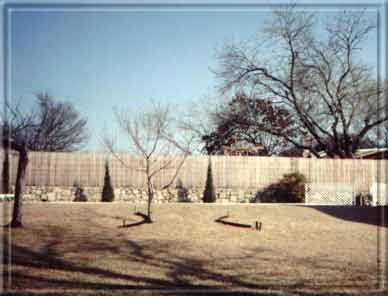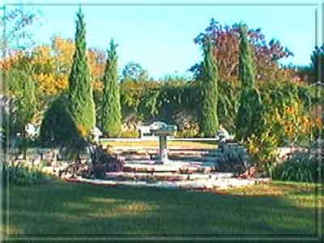|
The Gardenīs History
More than twenty years ago, this all began simply for the
sake of having beautiful blooms - but as all flower gardeners know, one bed leads to another until it morphs across the yard to become a garden.
To me, our land was just the "'yard" when visitors began
calling it an English Garden, in spite of the fact that it grows in Texas. It must be the structural lines and historically inspired features that instigate the adjective, rather than the actual plant materials
which must tolerate our prolonged hot summers. Although most of our plants are acclimated or indigenous to Southwestern U.S. as a matter of necessity, their selection and arrangements apparently contribute classical
forms.
My first attempt at taming our piece of the used-to-be
prairie began under 5 oak trees on top of a barren chalk hill. I naively wanted to see shrub-lets and ferns and some colorful blossoms from our living room window. Wasn't this a brilliant site to attempt my first
bed; the only place in the yard without any soil, light, or water? In the first shade bed and other expansions, I did everything wrong until I got it right. That is how I have learned to garden in Texas.
The state seems to be held together with a central spine of
lime. From this North Central section of Texas, down towards its tip, the underground consists of limestone boulders embedded in caliche lime paste, topped with a token of black clay. It would have easier to raise
cattle in the backyard, than flowers, which is why it was once grazing land instead of crop land. I am glad no one told me. I wanted a garden and just set to it.
Excavation for recent foundation work, below, reminds me of
the first few years of making borders on the prairie.
Little nooks have evolved into specific areas to accommodate the lay of the
land, my plant collecting mania (frustrated by an artist's urge for design), the plant's requirements and my lifelong yens. On our 1/2 acre suburban lot, the
classics of European landscaping have surfaced from childhood intrigues to inspire my tiny versions of features found in a turn-of-the-(last)-century garden.
For the sake of identification and sometimes with a bit of accuracy, we label the features as follows. These traditional elements are on a small scale to fit
within suburban confines and to keep the garden's size within my physical abilities.
|







